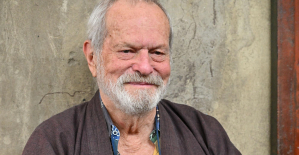Like an open-air theatre, the colossus of steel and concrete stretches into the deep blue sky: on the right and left two staircase-like, ascending ramps, poured out of tens of thousands of cubic meters of concrete. In the middle of a stage, a Steel platform with a weight of 700 tons. And behind the backdrop, beams, yet still a skeleton of steel and braces, but now 90 meters high. Here, in the jungle of French Guiana, in the case of more than 30 degrees Celsius and oppressive Humidity, but no theatre piece. The stage, one of the largest of its kind, is needed for something else: the first flight of a new European rocket called Ariane 6.
in mid-2020, it should be so far. Then, the 860-ton missile in Europe to guarantee access to space and probes to the space Agency, ESA. But it should play well on the world market, and companies such as the California missile forge Space-X competition. However, while the technical development, whether in French Guiana or at home in Europe – well, there is something else: on the money, but above all, the political will, the project is also in a difficult financial sign.
Extremely reliable, but from the time
After all: That Europe need a new missile, like someone denies. For the past 22 years, the Ariane 5 to carry the main burden of the European Space transport. More than 170 satellites has brought since then, into space; in September, her hundredth launch was celebrated. Almost all of them were – after initial problems – successfully. The Ariane 5 is therefore regarded as extremely reliable, however, also fallen out of time. Finally, it is designed to bring the very large science missions into space, or two heavy communication satellites.
these satellites are, however, always smaller and lighter become, and inflexible, double-starts wants to do hardly any operators. 2014 29 large satellites have been ordered for geostationary Orbit, were it in 2017, will have only ten. Less commercial launches – and less revenue – but for Europe's space-faring Nations, on the financial drip of the rocket, as before, that they would have to subsidize the Ariane 5 is much stronger.
more Flexible and cheaper to grow
that's Exactly why in French Guiana, the amphitheatre in the height, is only four kilometres to the West of the launch pad, the Ariane 5 on 4. In June 1996, for the first time took off. Flexible the new rocket should be just as reliable, but above all, 40 percent cheaper, so the full-bodied promises. The Europeans do not want to achieve, however, due to innovations or revolutionary technology, but to build small improvements, due to further developments, through a new way of missiles, and to start finally.
About a kilometre away from the massive launch table, the still iron Bender and dump trucks scurrying about, there is a nondescript building. With the naked eye it is visible in the construction site dust, and yet it means a Revolution in Europe's rocket. In him, the 62-Meter-long, Ariane 6 is to be screwed in the future, lying together and then to the start of the table to be rolled. You will be erect, and immediately veiled from the mobile launch tower, the 6000-ton colossus on rails, which is currently used as a steel skeleton on the edge of the construction site. Well protected you can be prepared for the Start.
Video – With a slight delay for the anniversary of flight In your hundredth flight has brought the European carrier rocket Ariane 5 successfully two Telecom satellites into space. Video: AFP
Yet, in the case of Ariane 5, were taken to all this preparatory work is in an upright position. The rocket, after all, is 52 meters high, had to be driven in a snail's pace from Station to Station and finally to the launch pad. It was expensive, but mainly it was tedious. Now everything should go faster.
In the tower are then installed, the lateral solid-fuel rocket, the Booster, the produce when you Lift the big part of the push. Her white, well-visible gases are passed 25 meters below the start of the table to the side and come up under the grandstand-like, gently rising concrete structures, the so-called flame trenches, back to the surface. Two boosters are enough for most of the planned satellite launches. For large science missions or heavy loads also four auxiliary rockets can be mounted. "Flexibility is an essential characteristic of the design", it is called the ESA. (Editorial Tamedia)
Created: 27.12.2018, 16:04 p.m.

 United States: divided on the question of presidential immunity, the Supreme Court offers respite to Trump
United States: divided on the question of presidential immunity, the Supreme Court offers respite to Trump Maurizio Molinari: “the Scurati affair, a European injury”
Maurizio Molinari: “the Scurati affair, a European injury” Hamas-Israel war: US begins construction of pier in Gaza
Hamas-Israel war: US begins construction of pier in Gaza Israel prepares to attack Rafah
Israel prepares to attack Rafah First three cases of “native” cholera confirmed in Mayotte
First three cases of “native” cholera confirmed in Mayotte Meningitis: compulsory vaccination for babies will be extended in 2025
Meningitis: compulsory vaccination for babies will be extended in 2025 Spain is the country in the European Union with the most overqualified workers for their jobs
Spain is the country in the European Union with the most overqualified workers for their jobs Parvovirus alert, the “fifth disease” of children which has already caused the death of five babies in 2024
Parvovirus alert, the “fifth disease” of children which has already caused the death of five babies in 2024 Falling wings of the Moulin Rouge: who will pay for the repairs?
Falling wings of the Moulin Rouge: who will pay for the repairs? “You don’t sell a company like that”: Roland Lescure “annoyed” by the prospect of a sale of Biogaran
“You don’t sell a company like that”: Roland Lescure “annoyed” by the prospect of a sale of Biogaran Insults, threats of suicide, violence... Attacks by France Travail agents will continue to soar in 2023
Insults, threats of suicide, violence... Attacks by France Travail agents will continue to soar in 2023 TotalEnergies boss plans primary listing in New York
TotalEnergies boss plans primary listing in New York La Pléiade arrives... in Pléiade
La Pléiade arrives... in Pléiade In Japan, an animation studio bets on its creators suffering from autism spectrum disorders
In Japan, an animation studio bets on its creators suffering from autism spectrum disorders Terry Gilliam, hero of the Annecy Festival, with Vice-Versa 2 and Garfield
Terry Gilliam, hero of the Annecy Festival, with Vice-Versa 2 and Garfield François Hollande, Stéphane Bern and Amélie Nothomb, heroes of one evening on the beach of the Cannes Film Festival
François Hollande, Stéphane Bern and Amélie Nothomb, heroes of one evening on the beach of the Cannes Film Festival Skoda Kodiaq 2024: a 'beast' plug-in hybrid SUV
Skoda Kodiaq 2024: a 'beast' plug-in hybrid SUV Tesla launches a new Model Y with 600 km of autonomy at a "more accessible price"
Tesla launches a new Model Y with 600 km of autonomy at a "more accessible price" The 10 best-selling cars in March 2024 in Spain: sales fall due to Easter
The 10 best-selling cars in March 2024 in Spain: sales fall due to Easter A private jet company buys more than 100 flying cars
A private jet company buys more than 100 flying cars This is how housing prices have changed in Spain in the last decade
This is how housing prices have changed in Spain in the last decade The home mortgage firm drops 10% in January and interest soars to 3.46%
The home mortgage firm drops 10% in January and interest soars to 3.46% The jewel of the Rocío de Nagüeles urbanization: a dream villa in Marbella
The jewel of the Rocío de Nagüeles urbanization: a dream villa in Marbella Rental prices grow by 7.3% in February: where does it go up and where does it go down?
Rental prices grow by 7.3% in February: where does it go up and where does it go down? Even on a mission for NATO, the Charles-de-Gaulle remains under French control, Lecornu responds to Mélenchon
Even on a mission for NATO, the Charles-de-Gaulle remains under French control, Lecornu responds to Mélenchon “Deadly Europe”, “economic decline”, immigration… What to remember from Emmanuel Macron’s speech at the Sorbonne
“Deadly Europe”, “economic decline”, immigration… What to remember from Emmanuel Macron’s speech at the Sorbonne Sale of Biogaran: The Republicans write to Emmanuel Macron
Sale of Biogaran: The Republicans write to Emmanuel Macron Europeans: “All those who claim that we don’t need Europe are liars”, criticizes Bayrou
Europeans: “All those who claim that we don’t need Europe are liars”, criticizes Bayrou These French cities that will boycott the World Cup in Qatar
These French cities that will boycott the World Cup in Qatar Medicine, family of athletes, New Zealand…, discovering Manae Feleu, the captain of the Bleues
Medicine, family of athletes, New Zealand…, discovering Manae Feleu, the captain of the Bleues Football: OM wants to extend Leonardo Balerdi
Football: OM wants to extend Leonardo Balerdi Six Nations F: France-England shatters the attendance record for women’s rugby in France
Six Nations F: France-England shatters the attendance record for women’s rugby in France Judo: eliminated in the 2nd round of the European Championships, Alpha Djalo in full doubt
Judo: eliminated in the 2nd round of the European Championships, Alpha Djalo in full doubt


















